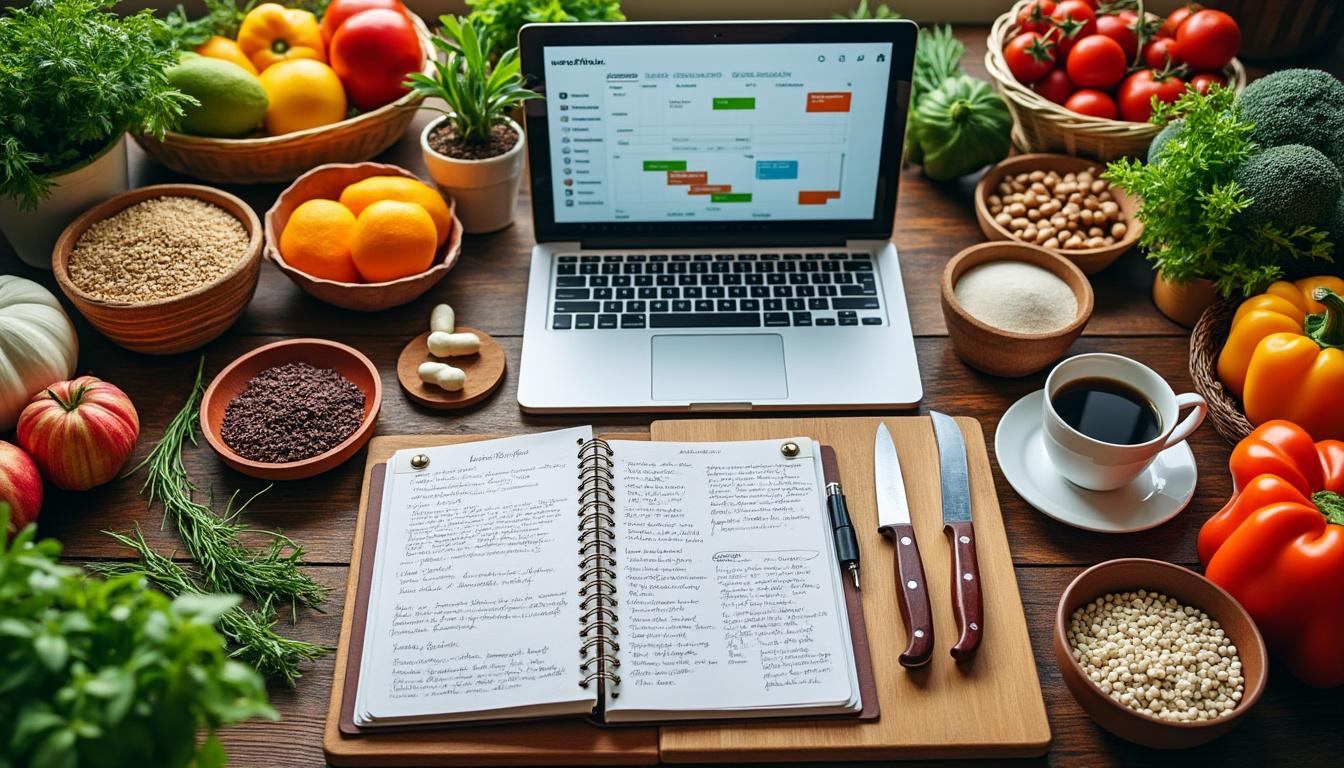Meal planning often presents a complex puzzle for individuals seeking efficient, nutritious, and budget-conscious dining options. For food professionals and enthusiasts alike, the weekly menu requires balancing diversity, health, time constraints, and accessibility. By integrating AI-assisted tools like ChatGPT into the meal planning process, new opportunities arise to streamline these tasks, optimize grocery shopping, and experiment with creative recipes without losing sight of nutritional goals or financial limits.
As meal delivery services such as Blue Apron, HelloFresh, and Sun Basket gain popularity, expectations for convenience and customization grow. Meanwhile, apps like Mealime and platforms like Snap Kitchen and Freshly offer tailored meal options, challenging traditional planning methods. This exploration examines the capabilities of ChatGPT when tasked with crafting a week’s meals, analyzing its strengths, limitations, and real-world applicability in the broader landscape of AI-capability-enhanced food preparation.
How AI Streamlines Meal Planning for Busy Professionals
The emergence of artificial intelligence in everyday life is reshaping how meal planning is approached, particularly for professionals juggling demanding schedules. ChatGPT, an advanced language model, leverages vast culinary databases and pattern recognition to propose meal plans that account for dietary restrictions, ingredient availability, and personal preferences. This technology reduces the cognitive load traditionally associated with choosing daily meals while encouraging diverse menus.
Meal planning hurdles often stem from the need to balance flavor variety with nutritional value and budget goals. AI tools like ChatGPT can suggest adaptable menus that scale ingredient quantities and time commitments efficiently. For example, integrating meal kits from providers like Green Chef or Home Chef with AI suggestions helps in aligning cost considerations with health priorities.
- Personalization: ChatGPT adjusts meal suggestions based on input about allergies, dietary styles (keto, vegan, gluten-free), and prep time.
- Time-saving: Automates the creation of grocery lists to reduce time spent in stores or online shopping.
- Budget optimization: Allows users to limit ingredient lists to seasonal or on-sale items, compatible with strategies highlighted in budget shopping guides.
- Variety and creativity: Proposes recipes outside typical weekly routines, aiding those seeking novel culinary experiences without extensive research.
This effectiveness is not just theoretical; professionals juggling business priorities find such automation invaluable. Consider the case of a mid-sized startup founder who used ChatGPT for weekly menus, leveraging suggestions that incorporated quick-cook staples from Snap Kitchen paired with fresh ingredients sourced locally. This strategy not only met nutritional needs but also eased meal prep stress significantly.
| Feature | Benefit | Example Service/Product |
|---|---|---|
| Meal customization | Adapts plan to dietary restrictions and preferences | Blue Apron, Green Chef |
| Automated grocery list | Reduces shopping time, prevents missing ingredients | Mealime, Home Chef |
| Recipe variety | Introduces new dishes to avoid repetition | Sun Basket, Territory Foods |
| Budget-conscious plans | Utilizes affordable staples and sales | Freshly, Trifecta |
Integrating AI-generated plans with the well-established services such as Blue Apron or HelloFresh creates an ecosystem that amplifies the benefits of automated meal design. The resulting fusion between technology and human taste preferences fosters synergy, cutting down planning effort by up to 90%, aligning closely with practical advice like the one presented in Meal Prep Within One Hour techniques.
Balancing Nutrition and Convenience Through AI Meal Plans
Translating health goals into actionable weekly meals is a challenge addressed increasingly through AI-enabled meal planning. ChatGPT’s ability to integrate nutritional knowledge converts raw data into user-specific menus balancing macronutrients, vitamins, and calories. This facilitates adherence to diet plans such as those favored by Terrifc Foods or the focused macronutrient strategies of Trifecta.
A significant advantage of AI-generated meal suggestions lies in their ability to reduce decision fatigue without compromising health ambitions. For example, users can input preferences for organic produce or low-carb options, and ChatGPT recalibrates menus to meet those standards while maintaining flavor variety. Additionally, AI can help replace or suggest alternatives for lesser-known foods, assisting users in exploring novel cuisines while managing allergy concerns or food intolerances.
- Macro tracking integration: Plans can align with fitness goals like muscle gain or weight loss guided by platforms like Trifecta.
- Accessible healthy eating: Promotes use of pantry staples to create balanced dishes, informed by strategies in Cook Pantry Staples Even When Broke.
- Quick and Easy Recipes: Focus on meals that require minimal prep, leveraging convenience from providers like Freshly and Snap Kitchen.
- Food Waste Reduction: Incorporates leftovers effectively, an approach supported by insights in Store Leftovers to Avoid Waste.
One illustrative scenario involves a working parent who used ChatGPT in combination with HelloFresh meal kits to ensure wholesome, ready-to-prepare dinners after a long workday. This eliminated guesswork and allowed the family to benefit from diverse recipes that respected their nutritional preferences while remaining within budget.
| Health Focus | Relevant Meal Service | Key Features |
|---|---|---|
| Weight Management | Trifecta | Macros tracked, calorie control |
| Organic & Sustainable | Green Chef, Sun Basket | Certified organic ingredients, eco-friendly sourcing |
| Quick Convenience | Freshly, Snap Kitchen | Pre-cooked options, under 30 minutes prep |
| Budget-Friendly Nutrition | Home Chef | Affordable, easy recipes using pantry staples |
This balance of health and convenience is crucial in sustaining consistent meal habits. Additionally, the meal prep techniques that AI supports align with guidelines found in Eat Healthy on a Tight Budget, addressing the universal barrier of affordability in nutritious diets.
Evaluating the Challenges and Limitations of AI-Generated Meal Plans
While AI-generated meal planning offers substantial convenience, several challenges and limitations must be recognized. ChatGPT’s reliance on textual data can lead to plans that occasionally lack cultural nuance, fail to incorporate personal taste subtleties, or depend on unavailable ingredients in some regions. These factors may result in menus that feel generic or impractical without human refinement.
Moreover, the success of AI meal plans heavily depends on the quality and accuracy of user input. Incorrect information about dietary restrictions or preferences might cause unsuitable suggestions. The integration between AI plans and delivery services such as Blue Apron or HelloFresh further depends on availability, pricing fluctuations, and regional logistics.
- Ingredient availability: AI may suggest items difficult to source locally.
- Lack of sensory input: No real-time tasting or appearance adjustments.
- Customization boundaries: Over-generalized recipes that need tweaking for personal preferences.
- Technological dependence: Requires users to be comfortable with digital tools and online shopping.
In one real-world example, a tech executive attempted to follow an AI-generated menu, only to discover the local market lacked several specialty ingredients. This necessitated back-and-forth adjustments and ultimately led to a hybrid approach combining AI plans with traditional meal kit services.
| Challenge | Impact | Potential Mitigation |
|---|---|---|
| Regional Ingredient Gaps | Menu impractical or incomplete | Custom input of local ingredient lists |
| Flavor and Texture Nuance | Less personalized taste experience | User feedback loops post-meal |
| User Input Errors | Unsuitable meal suggestions | Clear and repeated user prompts for accuracy |
| Technical Accessibility | Barrier for some demographics | Simple interfaces and tutorials |
The key to overcoming these hurdles lies in combining AI assistance with human oversight and adaptability. Resources like Cooking Secrets from Experts provide valuable additions that complement AI suggestions, offering tips for on-the-fly recipe adjustments and ingredient substitutions.
Leveraging AI for Budget-Friendly and Sustainable Culinary Habits
Budget constraints and sustainability considerations push many toward meal planning solutions that minimize waste, optimize ingredient use, and curb costs. ChatGPT facilitates this by generating meal ideas using pantry staples, seasonal produce, and versatile ingredients, guided by inputs regarding expenditure limits and ecological impact.
Meal kits like those offered by Territory Foods and Home Chef that emphasize organic and local sourcing integrate well with AI planning. The AI can suggest meal sequences that repurpose ingredients across several dishes, reducing perishables’ disposal and stretching the grocery budget. Such guidance aligns with strategies detailed in Store Leftovers to Avoid Waste and Cheap and Easy Dinners Under $10.
- Waste reduction: Plans recipes that use leftovers creatively.
- Seasonal ingredient focus: Promotes cost-effective and fresher options.
- Batch cooking suggestions: Enables preparing multiple meals to save time and energy.
- Shopping list prioritization: Organizes essentials to avoid impulsive or duplicate purchases.
For instance, a sustainability-conscious consumer employed ChatGPT to devise a two-week menu, incorporating recipes that reused core ingredients like roasted chicken or quinoa. This approach minimized food waste while maintaining variety through different seasoning profiles and cooking methods.
| Sustainability Strategy | Application | Result |
|---|---|---|
| Repurpose leftovers | Use chicken in salad, soup, and stir-fry | Reduced waste, cost savings |
| Seasonal buying | Focus on summer squash, tomatoes | Fresher taste, lower cost |
| Batch cooking | Prepare grains and sauces for multiple meals | Less prep time, energy efficient |
| Grocery organization | Prioritized shopping list minimizing excess | Streamlined grocery trips |
This model demonstrates how technological tools like ChatGPT contribute beyond convenience, driving meaningful improvements in household economics and environmental stewardship — themes also echoed in Kitchen Hacks to Save Time and Money.
Incorporating AI-Driven Meal Planning Into Modern Culinary Routines
Adopting tools such as ChatGPT for meal planning reflects a broader trend toward hybrid digital-personalized diets. When combined with meal delivery services like HelloFresh or Blue Apron, AI plans improve meal customization and streamline procurement. This fusion invites users to explore new cuisines, reduce stress, and meet nutritional goals more consistently.
The integration of AI-driven menus encourages more thoughtful cooking practices, including experimenting with new recipes that would otherwise require extensive research. With ChatGPT’s capacity to generate tailored prompts, users discover options ranging from classic comfort dishes to innovative, health-conscious meals compatible with Territory Foods’ wellness ethos or Sun Basket’s organic profile. This adaptability enhances culinary creativity, providing an accessible platform for meal discovery.
- Recipe innovation: AI suggests uncommon ingredients and international dishes.
- Meal delivery synergy: Aligns AI plans with available subscription kits for convenience.
- Dynamic adjustments: Quick plan revisions based on leftover inventory or schedule changes.
- Ongoing learning: AI improves meal proposals through user feedback and taste preferences.
Imagine a scenario where a culinary enthusiast combined AI-generated plans with meal kits from Home Chef, discovering unexpected dishes like Moroccan-spiced lamb or Asian-inspired grain bowls. This interaction fosters expanding palates while minimizing food preparation stress.
| Benefit | Example Application | User Outcome |
|---|---|---|
| Enhanced variety | Incorporating recipes across cuisines | Expanded culinary skills and enjoyment |
| Convenience | Meal kits matched with AI shopping lists | Reduced meal prep time |
| Flexibility | Adjust menus to current pantry contents | Reduced food waste and stress |
| Personalization | Adaptation based on dietary evolution | Consistent adherence to nutrition goals |
Such integration complements expert advice found in articles like Get Back in Shape from Home, linking meal quality with overall wellness and lifestyle improvements.
Frequently Asked Questions About Using ChatGPT for Meal Planning
- Can ChatGPT accommodate special dietary restrictions?
Yes, ChatGPT allows input of specific dietary needs such as allergies, veganism, keto, or gluten-free requirements, tailoring meal plans accordingly. - How does AI-generated meal planning save time?
By automating recipe suggestion and grocery list creation, AI reduces hours spent searching, planning, and shopping, enabling streamlined meal prep. - Is it cost-effective to rely on AI meal plans?
Often yes, especially when leveraging budget optimization features and integrating pantry staples or seasonal ingredients, as detailed in budgeting resources. - Can ChatGPT help reduce food waste?
Definitely. ChatGPT can suggest ways to repurpose leftovers and design meals that utilize ingredients fully, minimizing waste. - Do users need technical skills to use ChatGPT for meal planning?
Basic digital literacy suffices, and many platforms offer simple interfaces. Guidance is also available to help novice users engage effectively.

